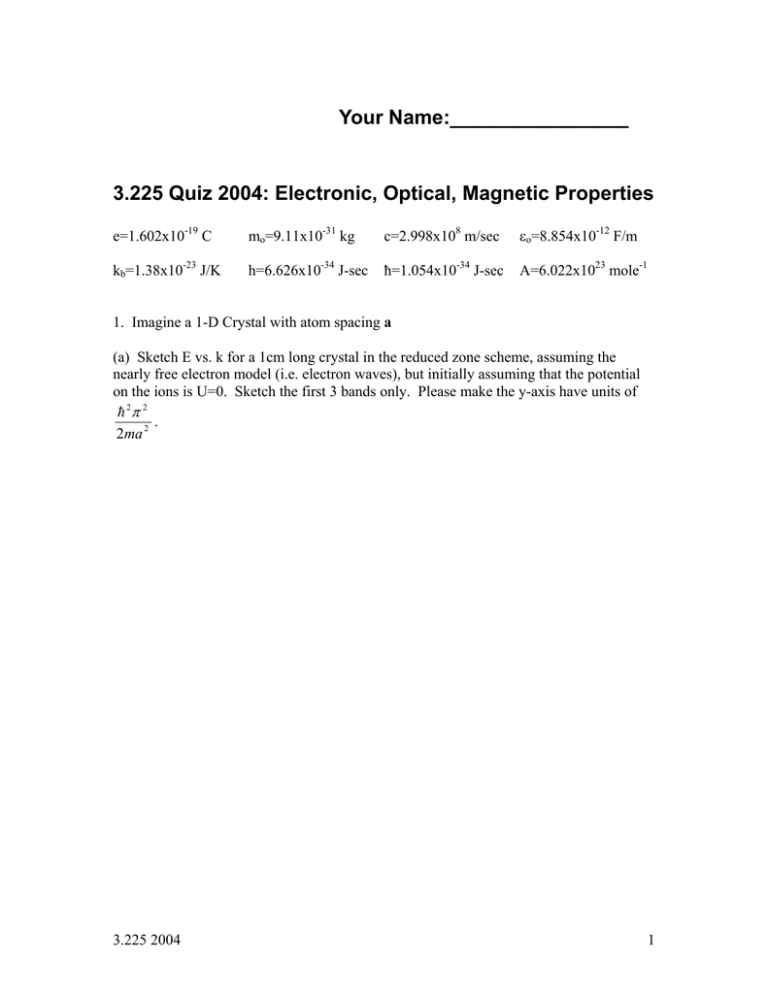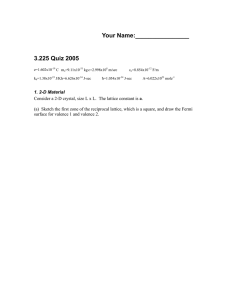Your Name:________________ 3.225 Quiz 2004: Electronic, Optical, Magnetic Properties
advertisement

Your Name:________________ 3.225 Quiz 2004: Electronic, Optical, Magnetic Properties e=1.602x10-19 C mo=9.11x10-31 kg c=2.998x108 m/sec εo=8.854x10-12 F/m kb=1.38x10-23 J/K h=6.626x10-34 J-sec ħ=1.054x10-34 J-sec A=6.022x1023 mole-1 1. Imagine a 1-D Crystal with atom spacing a (a) Sketch E vs. k for a 1cm long crystal in the reduced zone scheme, assuming the nearly free electron model (i.e. electron waves), but initially assuming that the potential on the ions is U=0. Sketch the first 3 bands only. Please make the y-axis have units of h 2π 2 . 2ma 2 3.225 2004 1 (b) Determine EF for the cases in which the atom in the crystal has a valence of 1, 2, or 3. (c) Estimate the conductivity at room temperature for valence 1, 2, or 3. 3.225 2004 2 (d) Now assume U = 1 h 2π 2 . Sketch E vs. k. Superimpose EF for valence 1, 2, 3. 2 2ma 2 (e) For which valence, if any, do you expect the conductivity to change substantially? Explain. 3.225 2004 3 (f) Re-sketch your answer in (d) for the case in which the 1-D crystal has length L=8a. How would the optical properties change? 3.225 2004 4 2. GaAs has a band gap of 1.423eV, a dielectric constant of 12.9, an electron effective mass of 0.063mo, a hole effective mass of 0.5mo, and a lattice constant of 0.5653nm. (a) GaAs is doped with Zn (column II) and RH is observed to be positive, where as GaAs is doped with Si (column IV) and RH is observed to be negative (i.e. like a good alkali metal). Describe what is happening. 3.225 2004 5 (b) Compare the optoelectronic properties of a p-n junction and a p++-n++ junction in GaAs. Assume that the doping is 1016 cm-3 in the p-n diode and 1020 cm-3 in the p++-n++ diode. In your estimation, plot the absorption coefficient and photocurrent generated in the photodiode from the conversion of light into carriers vs. ω, for 0<ω<1020 Hz. Indicate key frequencies, which should be quantitative, on the ω x-axis, but the y-axis “photocurrent” can be qualitative; although currents should be relative (i.e. y-axis is arbitrary units). 3.225 2004 6 3. The relative dielectric constant of silica (SiO2) is 3.9, the density is 2.3 g/cm3, the index of refraction is 1.46, and the atomic weight of Si and O are 28 and 16, respectively. (a) What is the electronic polarizability of silica? The ionic polarizability? 3.225 2004 7 (b) Assuming classical models for electronic and ionic polarizability, sketch � vs. � from �=0 to �=1020 Hz. 3.225 2004 8



